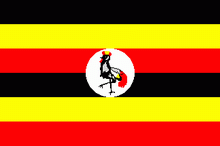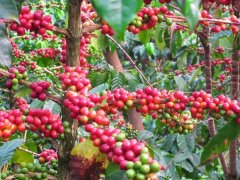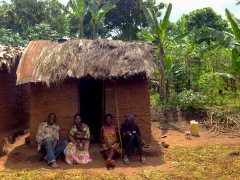Coffee producer Uganda introduces the flavor characteristics of Ugandan coffee beans

For professional baristas, please follow the coffee workshop (Wechat official account cafe_style)
Absolute position: 1 °21 & # 39x 13.57 "North 32 °17 & # 39x 15.45" East
Relative position of Uganda:
The Republic of Uganda, located in eastern Central Africa, reports a land area of 241,040 km 2 at latitude 1. 30. 39; S and 4. N. between and at longitude 29. 30 years old 39; and 35. Between E. It must be by Sudan in the north, Kenya in the east, Tanzania and Rwanda in the south, and the Democratic Republic of the Congo in the west. Completely, the country includes a plateau, generally between 1 200 and 1 500 m, dissected by many streams. In the west, the plateau is interrupted by cliffs to form lakes Edward and Albert, with Mount Ruwenzori (5110m) upthrust in the center, between the lakes. The extreme northern plateau extends across Nile into the western Nile region. The surplus of the southwest than the country is very hilly and more advanced. In the east, along the border with Kenya, three high mountains, Elgon (4321m), Kadam (3068m) and Moroto (3083m), are controlled. Nile divides the country in two, flows from Lake Victoria at Jinja through Lake Kyoga to the northern corner of Lake Albert, and then north to Sudan. An important proportion of the southern part of Uganda contains swamps. The climate is tropical but mild due to general heights. The temperature range ranges from about 16. To 29. C, with rainfall of 1 000 mm or more in most countries. In the extreme north-east, in Karamoja, there is a small area with rainfall of less than 500mm.
Ugandan coffee features:
Uganda, the seventh largest coffee producer in the world and the second largest coffee producer in Africa (after C ô te d'Ivoire), has also invited genetic engineering to replace the country's old coffee trees. Uganda plans to increase coffee production from 3.5 million bags (60 kg each) to 5 million bags per year within three to five years. This used to be a pipe dream, but now genetic engineering can complete the plan to increase production without any effort. Scientists selected the highly productive and disease-resistant Robusta coffee tree to replicate and replace the aging Ugandan coffee tree, a genetically modified variety that can blossom and bear fruit in two years to produce coffee beans, unlike the traditional five-year planting. A member of the Uganda Coffee Development Bureau pointed out that coffee diseases and insect pests are very serious at present, and the authorities hope that coffee farmers will grow newly cultivated coffee, which is more resistant to disease and has higher production capacity. Seedling farms can be seen everywhere in the coffee-producing areas of Uganda, and this large number of replicated saplings will eliminate 10% of the old coffee trees every year. How about the reputation of duplicated coffee? the Uganda Coffee Development Authority pointed out that there is absolutely no problem with safety. after being tested by experts, the evaluation is not bad, and international coffee traders treat this kind of replica coffee as Robusta coffee. Experts point out that the role of genetically engineered coffee trees is becoming more and more important. Although some people are worried about the poor flavor of this kind of coffee, there is no definite evidence in this regard, and the future development is worth observing.
Important Notice :
前街咖啡 FrontStreet Coffee has moved to new addredd:
FrontStreet Coffee Address: 315,Donghua East Road,GuangZhou
Tel:020 38364473
- Prev

Characteristics, uses and Origin of Ugandan Coffee & production Survey of Coffee products in Uganda over the years
For the exchange of professional baristas, please follow the coffee workshop (Wechat official account cafe_style) Uganda is a landlocked country in East Africa, known as the "Pearl of Africa". Because of the dependent colonial economy, coffee accounts for most of the export income. Coffee beans are a major commodity in global trading volume second only to crude oil, and the rise or fall of prices is related to coffee beans.
- Next

Uganda Coffee Bean-Peace Kawomera Cooperative for spreading Happiness, Peace and Music
Exchange of professional baristas follow the coffee workshop (Wechat official account cafe_style) JJK and coffee farmers. I saw a Ugandan man in his 50s, wearing a small Jewish hat, singing and dancing loudly to the music in the yard. As soon as he saw us, he gave me a big hug. He is the founder of the JJKPeace Kawomera Coffee Cooperative. ninety-one
Related
- Detailed explanation of Jadeite planting Land in Panamanian Jadeite Manor introduction to the grading system of Jadeite competitive bidding, Red bid, Green bid and Rose Summer
- Story of Coffee planting in Brenka region of Costa Rica Stonehenge Manor anaerobic heavy honey treatment of flavor mouth
- What's on the barrel of Blue Mountain Coffee beans?
- Can American coffee also pull flowers? How to use hot American style to pull out a good-looking pattern?
- Can you make a cold extract with coffee beans? What is the right proportion for cold-extracted coffee formula?
- Indonesian PWN Gold Mandrine Coffee Origin Features Flavor How to Chong? Mandolin coffee is American.
- A brief introduction to the flavor characteristics of Brazilian yellow bourbon coffee beans
- What is the effect of different water quality on the flavor of cold-extracted coffee? What kind of water is best for brewing coffee?
- Why do you think of Rose Summer whenever you mention Panamanian coffee?
- Introduction to the characteristics of authentic blue mountain coffee bean producing areas? What is the CIB Coffee Authority in Jamaica?

